
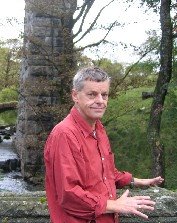
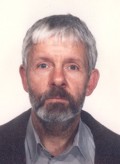
John Boswell, no relation to the great biographer, is a New Agey pianist from LA who once wrote a musical with Tim Robbins (well Susan Sarandon has already made her appearance in this blog, so you knew he was coming), while they were at UCLA (sorry but you got well and truly chomped!). He also did an album, The Painter, which includes the track "Back to York."
I was fortunate enough in Spring 1985 to win a Rotary Foundation Post-Graduate fellowship which would allow me to spend the following year on a M.A. course on the English Romantics at the University of York. I traveled around Great Britain a lot doing a slide show on differences between the US and the UK and more specifically similarities betwen the South and Yorkshire. One jokey example: clearly the US was bigger, better, and more powerful because we had AAA while Brits are stuck with AA for roadside assistance. That's right we're 1 better—to the accompaniment of slides showing car windows with
 red, white, and blue Triple A and
red, white, and blue Triple A and  yellow and black Automobile Association stickers. I also had a lengthy excursus on Panama City Beach and especially the famous Goofy Golf. The fact that we want to play putt putt through the legs of a giant paper mache T Rex says a lot about America's kinder sensibilites not to mention our general lack of historical education.
yellow and black Automobile Association stickers. I also had a lengthy excursus on Panama City Beach and especially the famous Goofy Golf. The fact that we want to play putt putt through the legs of a giant paper mache T Rex says a lot about America's kinder sensibilites not to mention our general lack of historical education. I was very lucky to be hosted by the Rotary Club of York (the oldest in the area and one which often features the Archbishop as an ex officio member). Back then they met weekly in the famous Royal York
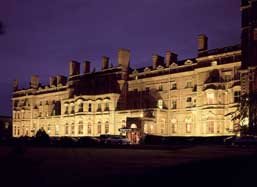
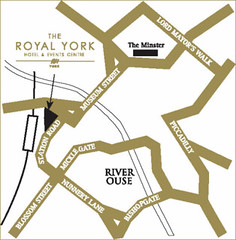
railway hotel and provided with a real opportunity to get an insider's view of many aspect of life in the North. I fondly remember a special tour around the eaves of York Minster as they were being repaired by a Rotarian's company, of course, after a major lightning strike (that's a rare opportunity to get that close to the genius of medieval engineering), stumbling through the waterlogged "ditches" that comprised parts of the Brönte Way walk only then to soar/well scramble up really onto the most glorious heaths you have ever seen. We started in Lancashire (probably at Wycoller and I should mention that many of the ewes had just calved) and ended in Yorkshire nearby the famous Haworth parsonage, all a bit of walking and fundraising. In fact the greetings and hospitality I met at every Rotary Club I visited were superb from Sheffield to Bradford to Harrogate to Wakefield and beyond. York, of course, was also an ideal situation for my own personal travel as it's not only a rare node for going east-west on the train service but also part of the East coast Intercity 125 service. A non-stop would get you to central London in under 2 hours! I often astounded my English undergrad friends when I told them I Had gone down to London for the day and was back. Morning train, quick early lunch a matinee show or shopping and then home. American and British senses of distance are quite different, probably due ot the relative sizes of our countries.
Yes, I learned a lot about Keats, Shelley et al. But I learned a whole lot more: how to shift with your left hand and drive on the "wrong" side of the road, what specific gravity is, what Peculier means when not referring to a religious division, how hard it is to come up with daily swim team workouts that don't rapidly become repetitive and boring, why Wensleydale with Bath Olivers is the snack of the gods, why Tetley's Bitter now Cask (the real ale not the tea) should have a foamy head and a soapy taste, how to properly cue an album for radio presentation at URY (memories from that experience here, how to hold original rare prints by the likes of Cruikshank and Gilray in your hands at the British Museum's prints and drawings department, how to format for and print A4 paper on an American laserjet set up for 8.5" x 11", why the Commonwealth games really are cool, why Timothy Taylor Landlord cask is one of the greatest pulls ever, why the cricket fans at Headingley piss of the London and especially MCC establishment, how to navigate central London's traffic grid (what was I thinking? 20 years on you could offer me a million pounds and I would refuse to drive inside the M 25!) et cetera, et cetera.
But this is an entry about some significant mentors not a glorious year abroad. I had three tutors on my course: Professor Tim Webb, Jack Donovan (like me an American), and Hugh Haughton (the then junior partner). I wish my memory were better but I've lost track of names from 20 years ago. I briefly visited York again in March 1987 and took this photo of my MA classmates who happened to still be in town for one reason or another.
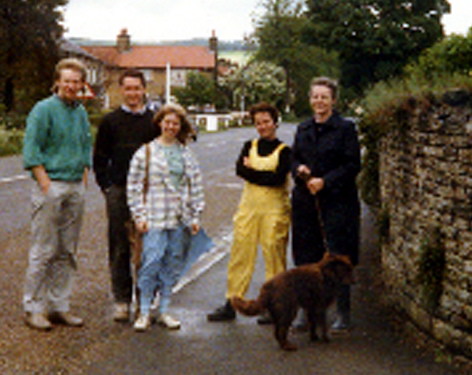
Tim Webb
Tim Webb was the senior fellow and leader of our merry band. He specialized in constructing devilish library problems usually involving an unexpected twist that required some kind of lateral thinking before one could begin to arrive at a proper answer, if one indeed existed. Thus the infamous Cervantes Shakespeare similar birthdates question.
Tim took an MA from Trinity College Dublin and D.Phil. from Oxford. His early academic work focused exclusively on Shelley with a sideturn into Romantic Hellenism. Before becoming a Professor at York in 1985 as I was arriving, he had also taught at Leeds and Michigan State. He moved with Professorship to Bristol in 1989 and spent the decade of the 90s as its Head. His further publications are too extensive to discuss here; let it suffice that the interested look here for further details.
The picture above captures something of the spirit of the Tim Webb I knew. The slightly (but only slightly) demonic glint in the eyes behind the doorknocker beard. He could crack the whip when it was needed; I remember an interesting office session after my first short paper offerings about standards. Let's just say it didn't happen again.
Jack Donovan
Like my position amongst the students on our course, Jack was the sole American Reader. He earned a BA from BU, an MA from KU, and a PhD from Birmingham. His early work on Samuel Butler's satiric masterpiece Hudibras came out as a series of articles in the 1970s. More recenty he has focussed on Shelley, serving as a contributing editor to Longman's edition of The Poems of Shelley and just now finishing up a Penguin Classics edition of Shelley's poetry and prose. Since I left York he appears to have gone part time and splits between the English Department and the now decade-old Centre for Eighteenth Century Studies.
Speaking of distances again. A funny thing: I once had a seminar paper due which was done but that I had forgotten to drop off. I called Jack at home from a phonebox outside my B&B on Skye and said I'd have it to him that afternoon; he was a bit shocked when I told him where I was. We still managed to tool around Ben Nevis and across the lunar landscape that is central Scotland before doing a late lunch in Auld Reekie and then jamming down the A-68 to the A1 at Darlington en route to Heslington.
I did my very best to draw up a list of common differences between English and American spelling to avoid "errour" in my M.A. thesis, but more than a few Americanisms slipped through I can assure you. Rumor has it (well Tim Webb told me when I visited in the Spring of 1987) that Jack had done the yeoman's chore of whiting out and correcting these items in the final copy. Thanks!
Hugh Haughton
Junior partner in our triumvir of teachers. Hugh took his BA from Cambridge and an MA from Oxford assuming a lectureship at York before completing a D.Phil. 20 years ago this became a running gag with the other course leaders as Hugh notoriously "missed" deadlines, including some long forgotten (at least by me) essay. But a cursory glance at his academic biography tells an utterly different story now. The advantages of a system which allows ideas time to percolate are manifest. He has become a recognized expert and well published in no less than 3 (count 'em) distinct fields! There's nonsense lit where he did a definitive edition of Lewis Carroll's two Alice novels as well as one of Kipling's Wee Willie Winkie plus he edited The Chatto Book of Nonsense Verse. In Romanticism, he edited the first major collection of essays on the newly canonical John Clare, a poet I was first introduced to by John Brewer in the spring of 1983. And then there's the Moderns be they poets or Irish writers of any ilk belying his roots in Cork. His major study of Derek Mahon is forthcoming.
Personally I was always fascinated by Hugh's interest in any scratchy old vinyl he could find, be it blues, jazz, or classical. We managed to talk jazz which was the area of those three I was most knowledgeable about then; I've done a lot of gruntwork on the blues since then, but that's another story. I first heard Enrico Caruso in the seminar, when he played us a bit of a recording of Beethoven's Fidelio, a truly memorable auditory experience. He was in attendance when I tried to enliven our seminar by casting my discussion of some rare lost ms in the terms of one of Dr. Watson's narratives of a case for Holmes, but was kind enough only to critique the one or two anachronisms, linguistically speaking.
YORK M.A. thesis
Looking back at my thesis on The Parlance of Peterloo: Common Themes in Discordant Reactions to the Manchester Massacre, I'm still surprised by how little major work has been done on this central event in the general revolutionary history of Enlightenment England. I guess people too easily take such a famous event for granted without fully understanding it. I know since writing my thesis there's been at least one major book and some significant coverage in Chandler's England in 1819 not to mention Jeremy Black's conterfactual revisonism of said event, but still . . . . I mean Melvyn Bragg didn't get around to the Manchester Massacre until late last year. I suspect if I did the thesis now it would have a much heavier theoretical component. What exactly did I mean by "verbal," "visual," and "iconography." Are there any complex reasons that conservatives and radicals alike used the same iconography to describe the events, merely changing to whom each symbol referred? Why was the primarily biblical imagery of the Pale Rider so apt here? Surely there are other icons of death available for deployment (unless of course it really was all about Wellington's troops and his supposed "whiteness")? If I had actually re-read the thing after 20 years, I suspect there'd be far more question to think about. I'd also be forced to deal more with all of Ronald Paulson's oeuvre. I can only imagine what directions John Barrell would have pushed me in had he been at York in 1985-6. Still I learned a lot, got to deal with my beloved, crabby conservative Scott "once more," and actually held some Cruikshanks and Gilrays in my gloveless mitts down Bloomsbury way.
Serious Coda and a Moment of Quiet Reflection
I recently learned that my dear Rotarian host, Dennis A. Nicholls, formerly of Strensall and Terry's and Rowntree Mackintosh, passed after 88 wonderful years. Here's a picture from the last time I saw him in the back beer garden of Heslington's Charles XII pub:
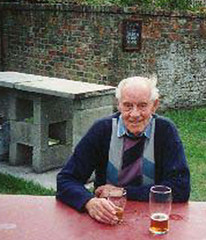
I am extremely sorry my condolences are so belated. But deeply heartfelt thoughts for Elizabeth, Penelope and Robert, and for all the grandchildren and the one great-grandson. I'll always remember Christmas day 1985 with the Queen, crackers, and the lot.
Official notice of his service of celebration can be found here.
His wonderful spirit continues to surround me at home, as I have framed many of his famous Christmas cards which were fronted by intricate pen and ink drawings of typical York scenes. Here's a few examples:
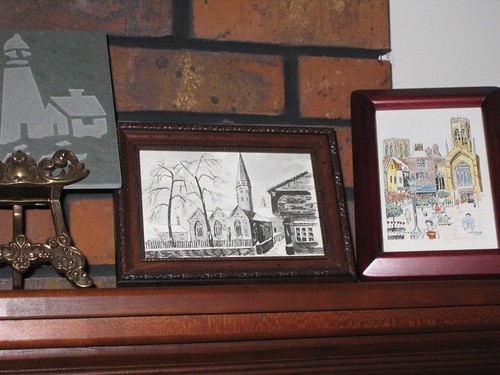
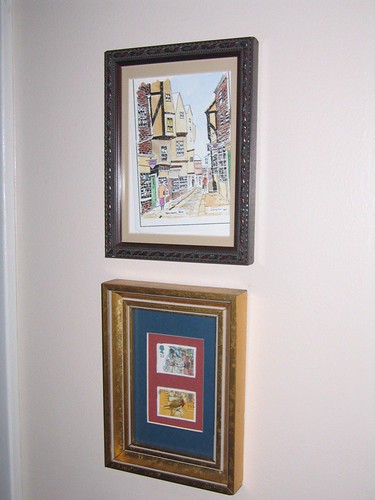
Ta.
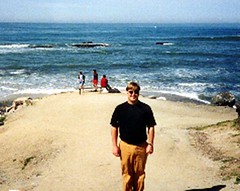
1 comment:
We are pleased you enjoyed your year in York. The Rotary Club goes on and has partially moved into the new world of technology and has a web site at www.yorkrotary.co.uk which may renew a few memories.
Regards - Michael Wilson - Webmaster
PS - I was Dennis Nicholls doctor for many years before I retired.
Post a Comment